Detailed Audit Process Proposal and Analysis for Micron Technology
VerifiedAdded on 2023/03/30
|12
|2419
|110
Report
AI Summary
This report provides a detailed internal audit proposal for Micron Technology, encompassing various aspects of the company's operations and financial controls. The proposal outlines the objectives of the audit, which include assessing the completeness and accuracy of financial information. It delves into entity-level controls, such as asset management, policies, standards, procedures, and employee management, highlighting their importance in maintaining organizational integrity and financial stability. The audit also evaluates the use of hardware components like firewalls, data storage, and switches, alongside software environments. Furthermore, the proposal selects five specific audit option items, including the use of a wireless network segment, a database, a web server, a Microsoft Windows environment, and a data center, analyzing the risks and controls associated with each. The report emphasizes the importance of security audits and the implementation of strong internal controls to mitigate risks and ensure the reliability of financial reporting. The audit methodology includes reviews of technical materials, security publications, and adherence to professional auditing standards to provide reasonable assurance to stakeholders.
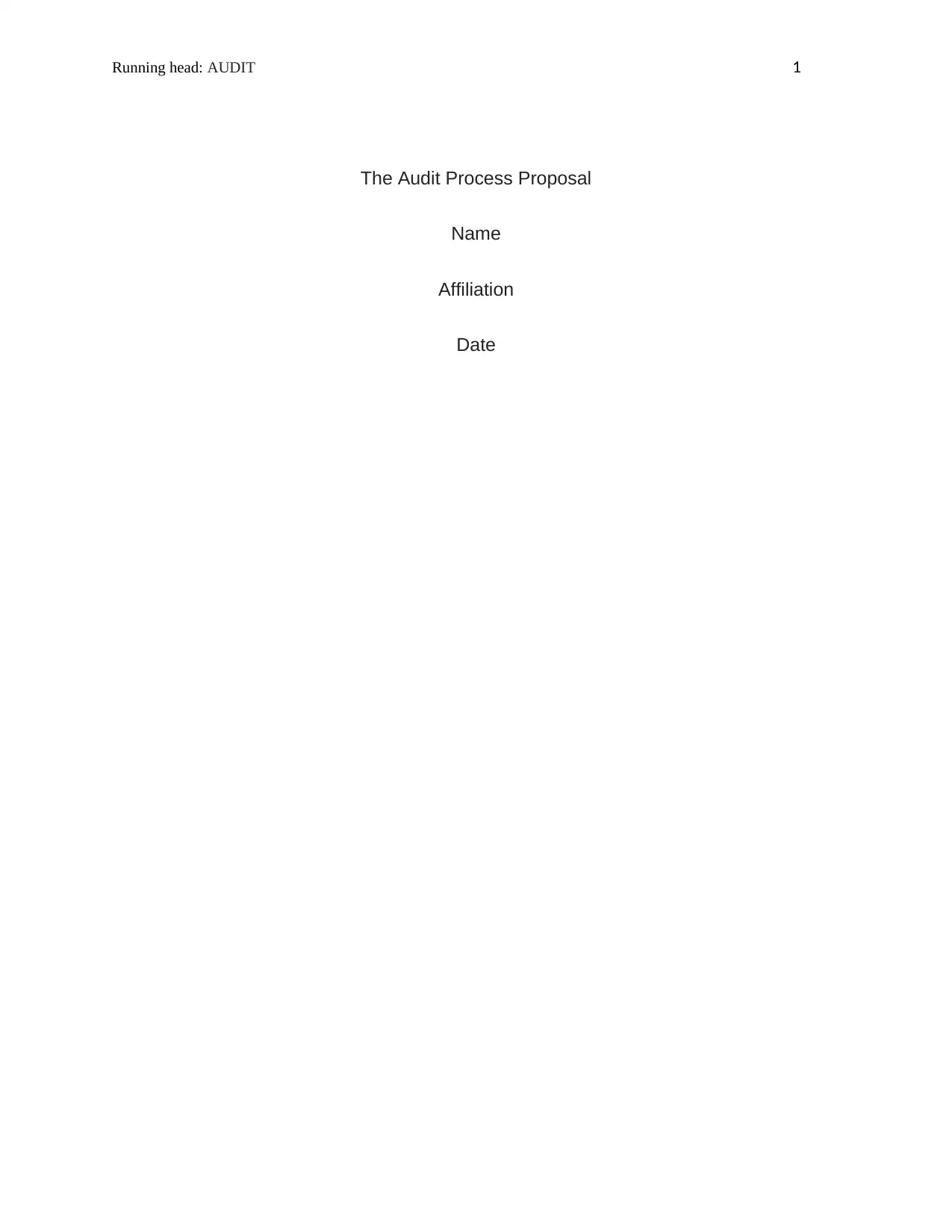
Running head: AUDIT 1
The Audit Process Proposal
Name
Affiliation
Date
The Audit Process Proposal
Name
Affiliation
Date
Paraphrase This Document
Need a fresh take? Get an instant paraphrase of this document with our AI Paraphraser
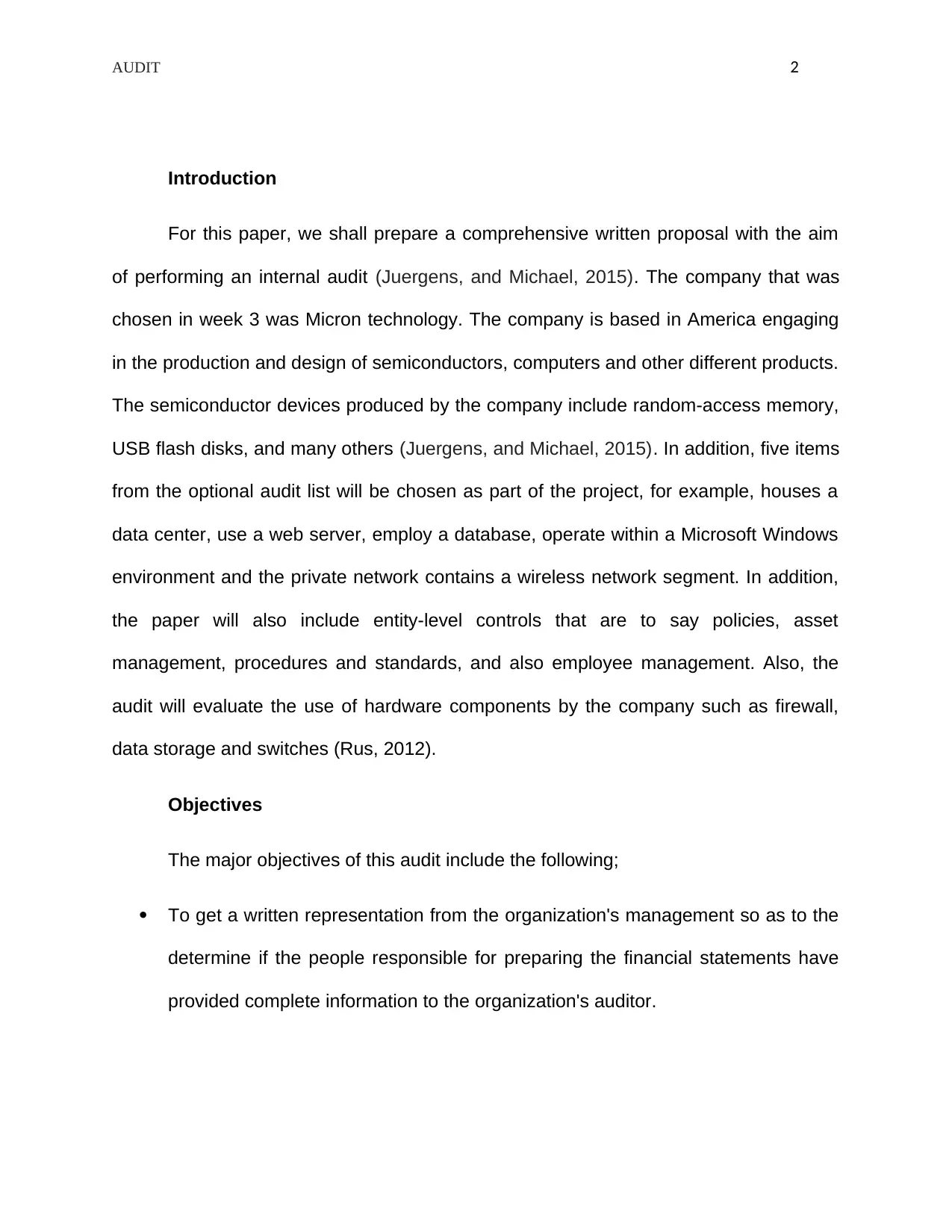
AUDIT 2
Introduction
For this paper, we shall prepare a comprehensive written proposal with the aim
of performing an internal audit (Juergens, and Michael, 2015). The company that was
chosen in week 3 was Micron technology. The company is based in America engaging
in the production and design of semiconductors, computers and other different products.
The semiconductor devices produced by the company include random-access memory,
USB flash disks, and many others (Juergens, and Michael, 2015). In addition, five items
from the optional audit list will be chosen as part of the project, for example, houses a
data center, use a web server, employ a database, operate within a Microsoft Windows
environment and the private network contains a wireless network segment. In addition,
the paper will also include entity-level controls that are to say policies, asset
management, procedures and standards, and also employee management. Also, the
audit will evaluate the use of hardware components by the company such as firewall,
data storage and switches (Rus, 2012).
Objectives
The major objectives of this audit include the following;
To get a written representation from the organization's management so as to the
determine if the people responsible for preparing the financial statements have
provided complete information to the organization's auditor.
Introduction
For this paper, we shall prepare a comprehensive written proposal with the aim
of performing an internal audit (Juergens, and Michael, 2015). The company that was
chosen in week 3 was Micron technology. The company is based in America engaging
in the production and design of semiconductors, computers and other different products.
The semiconductor devices produced by the company include random-access memory,
USB flash disks, and many others (Juergens, and Michael, 2015). In addition, five items
from the optional audit list will be chosen as part of the project, for example, houses a
data center, use a web server, employ a database, operate within a Microsoft Windows
environment and the private network contains a wireless network segment. In addition,
the paper will also include entity-level controls that are to say policies, asset
management, procedures and standards, and also employee management. Also, the
audit will evaluate the use of hardware components by the company such as firewall,
data storage and switches (Rus, 2012).
Objectives
The major objectives of this audit include the following;
To get a written representation from the organization's management so as to the
determine if the people responsible for preparing the financial statements have
provided complete information to the organization's auditor.
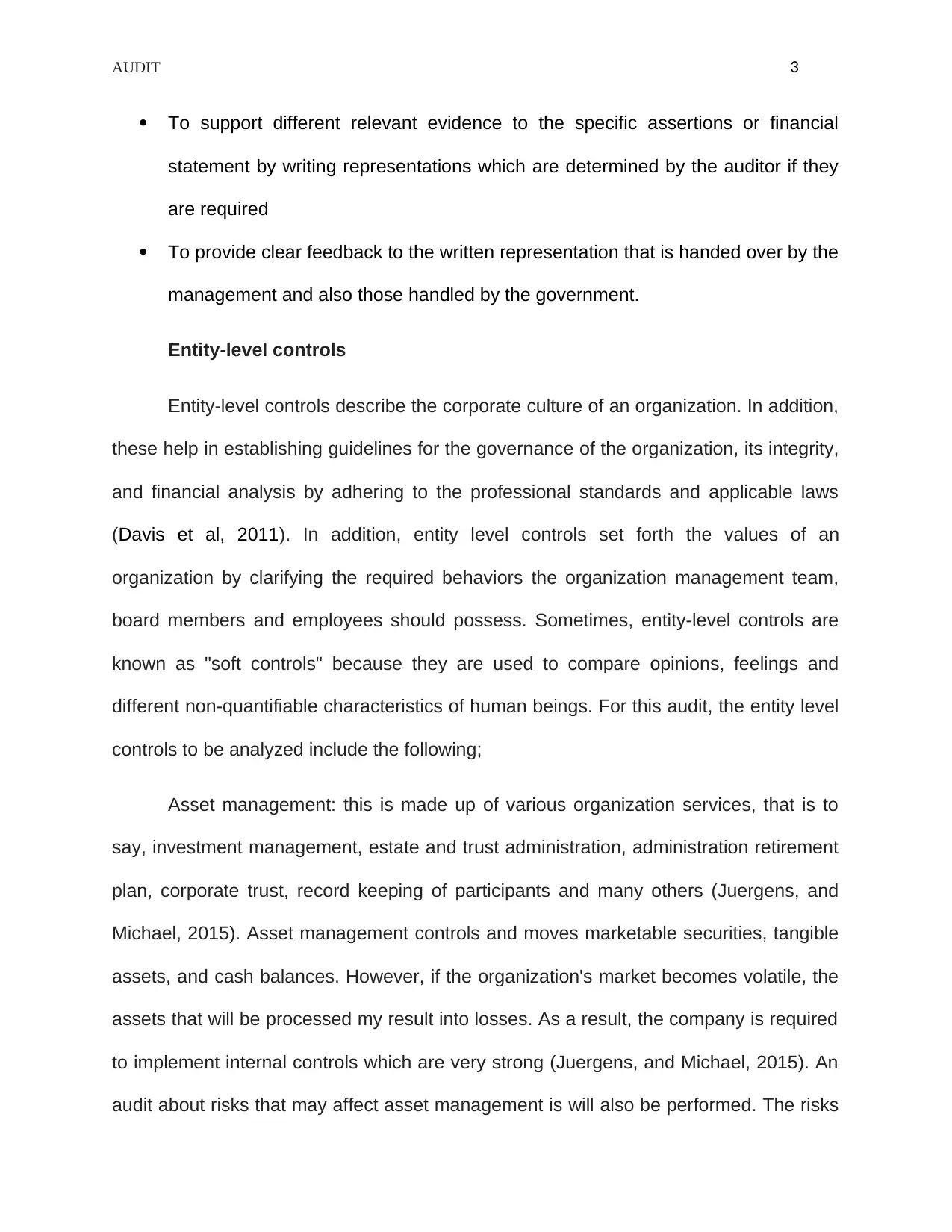
AUDIT 3
To support different relevant evidence to the specific assertions or financial
statement by writing representations which are determined by the auditor if they
are required
To provide clear feedback to the written representation that is handed over by the
management and also those handled by the government.
Entity-level controls
Entity-level controls describe the corporate culture of an organization. In addition,
these help in establishing guidelines for the governance of the organization, its integrity,
and financial analysis by adhering to the professional standards and applicable laws
(Davis et al, 2011). In addition, entity level controls set forth the values of an
organization by clarifying the required behaviors the organization management team,
board members and employees should possess. Sometimes, entity-level controls are
known as "soft controls" because they are used to compare opinions, feelings and
different non-quantifiable characteristics of human beings. For this audit, the entity level
controls to be analyzed include the following;
Asset management: this is made up of various organization services, that is to
say, investment management, estate and trust administration, administration retirement
plan, corporate trust, record keeping of participants and many others (Juergens, and
Michael, 2015). Asset management controls and moves marketable securities, tangible
assets, and cash balances. However, if the organization's market becomes volatile, the
assets that will be processed my result into losses. As a result, the company is required
to implement internal controls which are very strong (Juergens, and Michael, 2015). An
audit about risks that may affect asset management is will also be performed. The risks
To support different relevant evidence to the specific assertions or financial
statement by writing representations which are determined by the auditor if they
are required
To provide clear feedback to the written representation that is handed over by the
management and also those handled by the government.
Entity-level controls
Entity-level controls describe the corporate culture of an organization. In addition,
these help in establishing guidelines for the governance of the organization, its integrity,
and financial analysis by adhering to the professional standards and applicable laws
(Davis et al, 2011). In addition, entity level controls set forth the values of an
organization by clarifying the required behaviors the organization management team,
board members and employees should possess. Sometimes, entity-level controls are
known as "soft controls" because they are used to compare opinions, feelings and
different non-quantifiable characteristics of human beings. For this audit, the entity level
controls to be analyzed include the following;
Asset management: this is made up of various organization services, that is to
say, investment management, estate and trust administration, administration retirement
plan, corporate trust, record keeping of participants and many others (Juergens, and
Michael, 2015). Asset management controls and moves marketable securities, tangible
assets, and cash balances. However, if the organization's market becomes volatile, the
assets that will be processed my result into losses. As a result, the company is required
to implement internal controls which are very strong (Juergens, and Michael, 2015). An
audit about risks that may affect asset management is will also be performed. The risks
⊘ This is a preview!⊘
Do you want full access?
Subscribe today to unlock all pages.

Trusted by 1+ million students worldwide
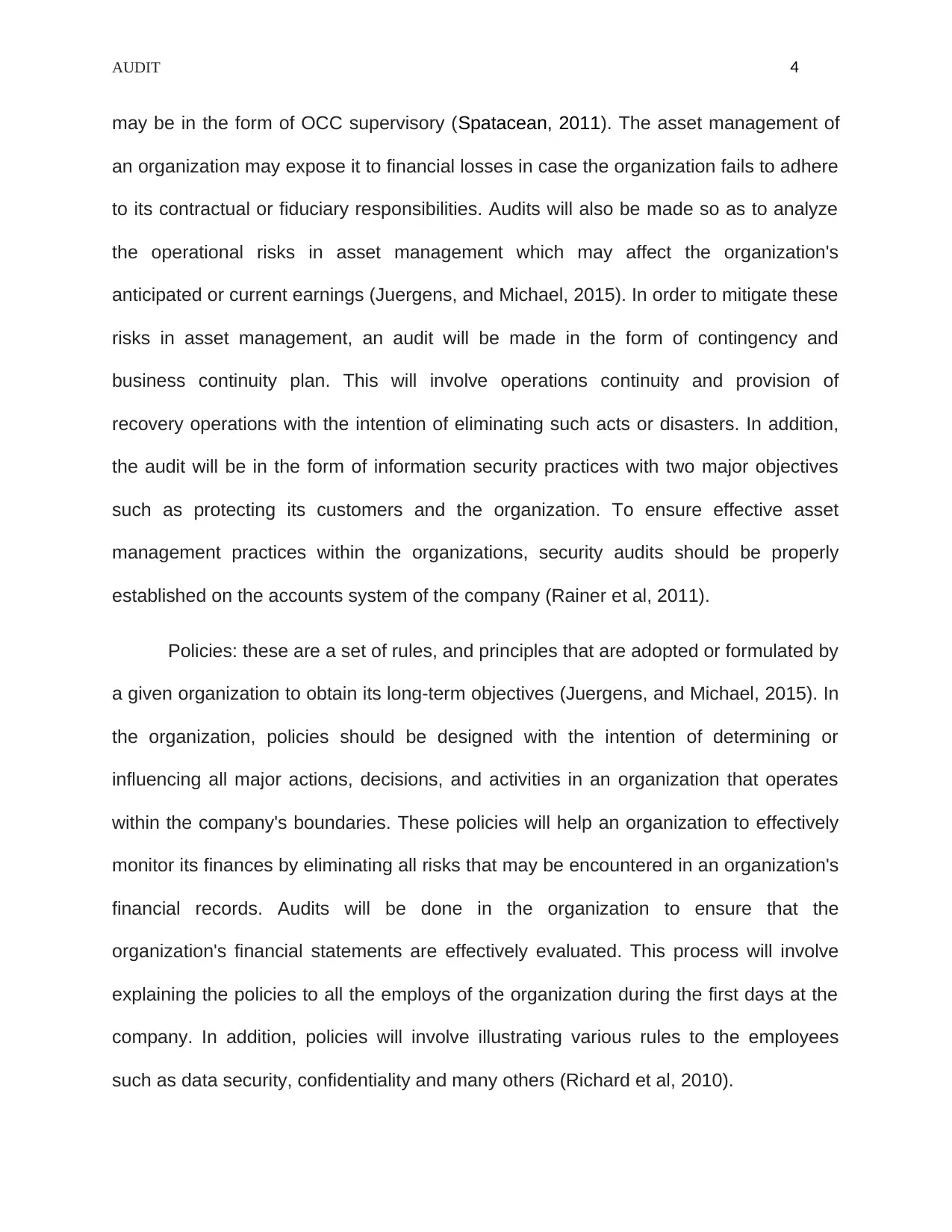
AUDIT 4
may be in the form of OCC supervisory (Spatacean, 2011). The asset management of
an organization may expose it to financial losses in case the organization fails to adhere
to its contractual or fiduciary responsibilities. Audits will also be made so as to analyze
the operational risks in asset management which may affect the organization's
anticipated or current earnings (Juergens, and Michael, 2015). In order to mitigate these
risks in asset management, an audit will be made in the form of contingency and
business continuity plan. This will involve operations continuity and provision of
recovery operations with the intention of eliminating such acts or disasters. In addition,
the audit will be in the form of information security practices with two major objectives
such as protecting its customers and the organization. To ensure effective asset
management practices within the organizations, security audits should be properly
established on the accounts system of the company (Rainer et al, 2011).
Policies: these are a set of rules, and principles that are adopted or formulated by
a given organization to obtain its long-term objectives (Juergens, and Michael, 2015). In
the organization, policies should be designed with the intention of determining or
influencing all major actions, decisions, and activities in an organization that operates
within the company's boundaries. These policies will help an organization to effectively
monitor its finances by eliminating all risks that may be encountered in an organization's
financial records. Audits will be done in the organization to ensure that the
organization's financial statements are effectively evaluated. This process will involve
explaining the policies to all the employs of the organization during the first days at the
company. In addition, policies will involve illustrating various rules to the employees
such as data security, confidentiality and many others (Richard et al, 2010).
may be in the form of OCC supervisory (Spatacean, 2011). The asset management of
an organization may expose it to financial losses in case the organization fails to adhere
to its contractual or fiduciary responsibilities. Audits will also be made so as to analyze
the operational risks in asset management which may affect the organization's
anticipated or current earnings (Juergens, and Michael, 2015). In order to mitigate these
risks in asset management, an audit will be made in the form of contingency and
business continuity plan. This will involve operations continuity and provision of
recovery operations with the intention of eliminating such acts or disasters. In addition,
the audit will be in the form of information security practices with two major objectives
such as protecting its customers and the organization. To ensure effective asset
management practices within the organizations, security audits should be properly
established on the accounts system of the company (Rainer et al, 2011).
Policies: these are a set of rules, and principles that are adopted or formulated by
a given organization to obtain its long-term objectives (Juergens, and Michael, 2015). In
the organization, policies should be designed with the intention of determining or
influencing all major actions, decisions, and activities in an organization that operates
within the company's boundaries. These policies will help an organization to effectively
monitor its finances by eliminating all risks that may be encountered in an organization's
financial records. Audits will be done in the organization to ensure that the
organization's financial statements are effectively evaluated. This process will involve
explaining the policies to all the employs of the organization during the first days at the
company. In addition, policies will involve illustrating various rules to the employees
such as data security, confidentiality and many others (Richard et al, 2010).
Paraphrase This Document
Need a fresh take? Get an instant paraphrase of this document with our AI Paraphraser
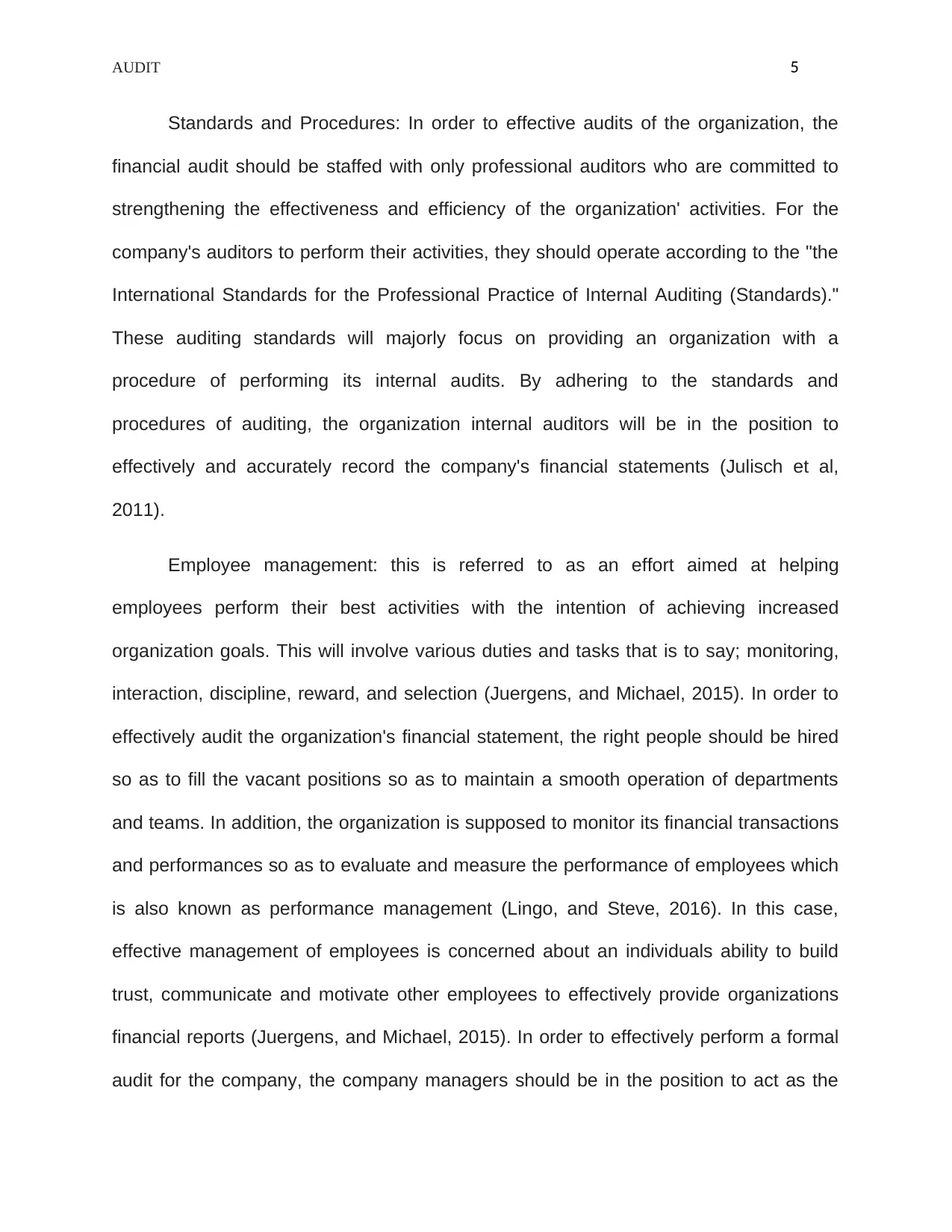
AUDIT 5
Standards and Procedures: In order to effective audits of the organization, the
financial audit should be staffed with only professional auditors who are committed to
strengthening the effectiveness and efficiency of the organization' activities. For the
company's auditors to perform their activities, they should operate according to the "the
International Standards for the Professional Practice of Internal Auditing (Standards)."
These auditing standards will majorly focus on providing an organization with a
procedure of performing its internal audits. By adhering to the standards and
procedures of auditing, the organization internal auditors will be in the position to
effectively and accurately record the company's financial statements (Julisch et al,
2011).
Employee management: this is referred to as an effort aimed at helping
employees perform their best activities with the intention of achieving increased
organization goals. This will involve various duties and tasks that is to say; monitoring,
interaction, discipline, reward, and selection (Juergens, and Michael, 2015). In order to
effectively audit the organization's financial statement, the right people should be hired
so as to fill the vacant positions so as to maintain a smooth operation of departments
and teams. In addition, the organization is supposed to monitor its financial transactions
and performances so as to evaluate and measure the performance of employees which
is also known as performance management (Lingo, and Steve, 2016). In this case,
effective management of employees is concerned about an individuals ability to build
trust, communicate and motivate other employees to effectively provide organizations
financial reports (Juergens, and Michael, 2015). In order to effectively perform a formal
audit for the company, the company managers should be in the position to act as the
Standards and Procedures: In order to effective audits of the organization, the
financial audit should be staffed with only professional auditors who are committed to
strengthening the effectiveness and efficiency of the organization' activities. For the
company's auditors to perform their activities, they should operate according to the "the
International Standards for the Professional Practice of Internal Auditing (Standards)."
These auditing standards will majorly focus on providing an organization with a
procedure of performing its internal audits. By adhering to the standards and
procedures of auditing, the organization internal auditors will be in the position to
effectively and accurately record the company's financial statements (Julisch et al,
2011).
Employee management: this is referred to as an effort aimed at helping
employees perform their best activities with the intention of achieving increased
organization goals. This will involve various duties and tasks that is to say; monitoring,
interaction, discipline, reward, and selection (Juergens, and Michael, 2015). In order to
effectively audit the organization's financial statement, the right people should be hired
so as to fill the vacant positions so as to maintain a smooth operation of departments
and teams. In addition, the organization is supposed to monitor its financial transactions
and performances so as to evaluate and measure the performance of employees which
is also known as performance management (Lingo, and Steve, 2016). In this case,
effective management of employees is concerned about an individuals ability to build
trust, communicate and motivate other employees to effectively provide organizations
financial reports (Juergens, and Michael, 2015). In order to effectively perform a formal
audit for the company, the company managers should be in the position to act as the
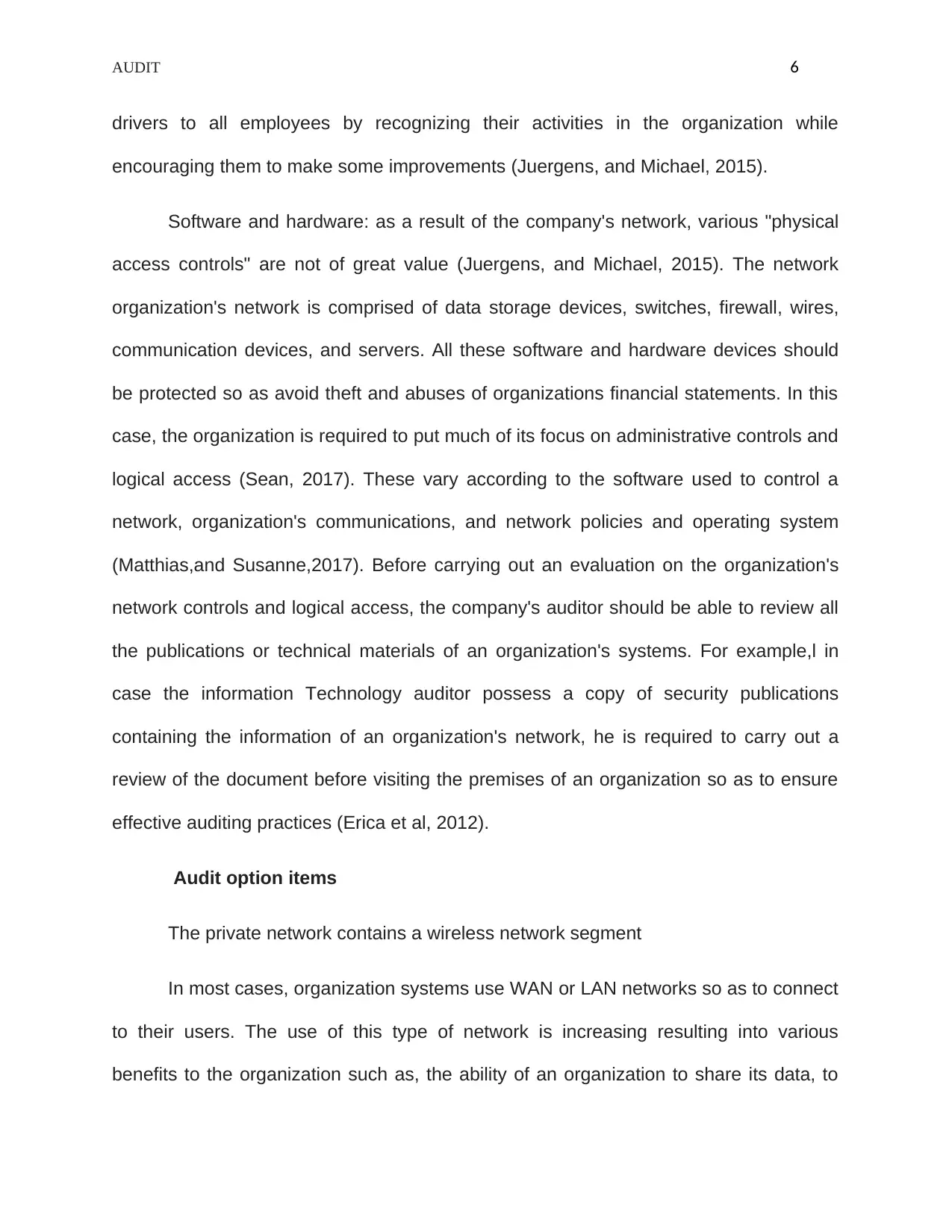
AUDIT 6
drivers to all employees by recognizing their activities in the organization while
encouraging them to make some improvements (Juergens, and Michael, 2015).
Software and hardware: as a result of the company's network, various "physical
access controls" are not of great value (Juergens, and Michael, 2015). The network
organization's network is comprised of data storage devices, switches, firewall, wires,
communication devices, and servers. All these software and hardware devices should
be protected so as avoid theft and abuses of organizations financial statements. In this
case, the organization is required to put much of its focus on administrative controls and
logical access (Sean, 2017). These vary according to the software used to control a
network, organization's communications, and network policies and operating system
(Matthias,and Susanne,2017). Before carrying out an evaluation on the organization's
network controls and logical access, the company's auditor should be able to review all
the publications or technical materials of an organization's systems. For example,l in
case the information Technology auditor possess a copy of security publications
containing the information of an organization's network, he is required to carry out a
review of the document before visiting the premises of an organization so as to ensure
effective auditing practices (Erica et al, 2012).
Audit option items
The private network contains a wireless network segment
In most cases, organization systems use WAN or LAN networks so as to connect
to their users. The use of this type of network is increasing resulting into various
benefits to the organization such as, the ability of an organization to share its data, to
drivers to all employees by recognizing their activities in the organization while
encouraging them to make some improvements (Juergens, and Michael, 2015).
Software and hardware: as a result of the company's network, various "physical
access controls" are not of great value (Juergens, and Michael, 2015). The network
organization's network is comprised of data storage devices, switches, firewall, wires,
communication devices, and servers. All these software and hardware devices should
be protected so as avoid theft and abuses of organizations financial statements. In this
case, the organization is required to put much of its focus on administrative controls and
logical access (Sean, 2017). These vary according to the software used to control a
network, organization's communications, and network policies and operating system
(Matthias,and Susanne,2017). Before carrying out an evaluation on the organization's
network controls and logical access, the company's auditor should be able to review all
the publications or technical materials of an organization's systems. For example,l in
case the information Technology auditor possess a copy of security publications
containing the information of an organization's network, he is required to carry out a
review of the document before visiting the premises of an organization so as to ensure
effective auditing practices (Erica et al, 2012).
Audit option items
The private network contains a wireless network segment
In most cases, organization systems use WAN or LAN networks so as to connect
to their users. The use of this type of network is increasing resulting into various
benefits to the organization such as, the ability of an organization to share its data, to
⊘ This is a preview!⊘
Do you want full access?
Subscribe today to unlock all pages.

Trusted by 1+ million students worldwide
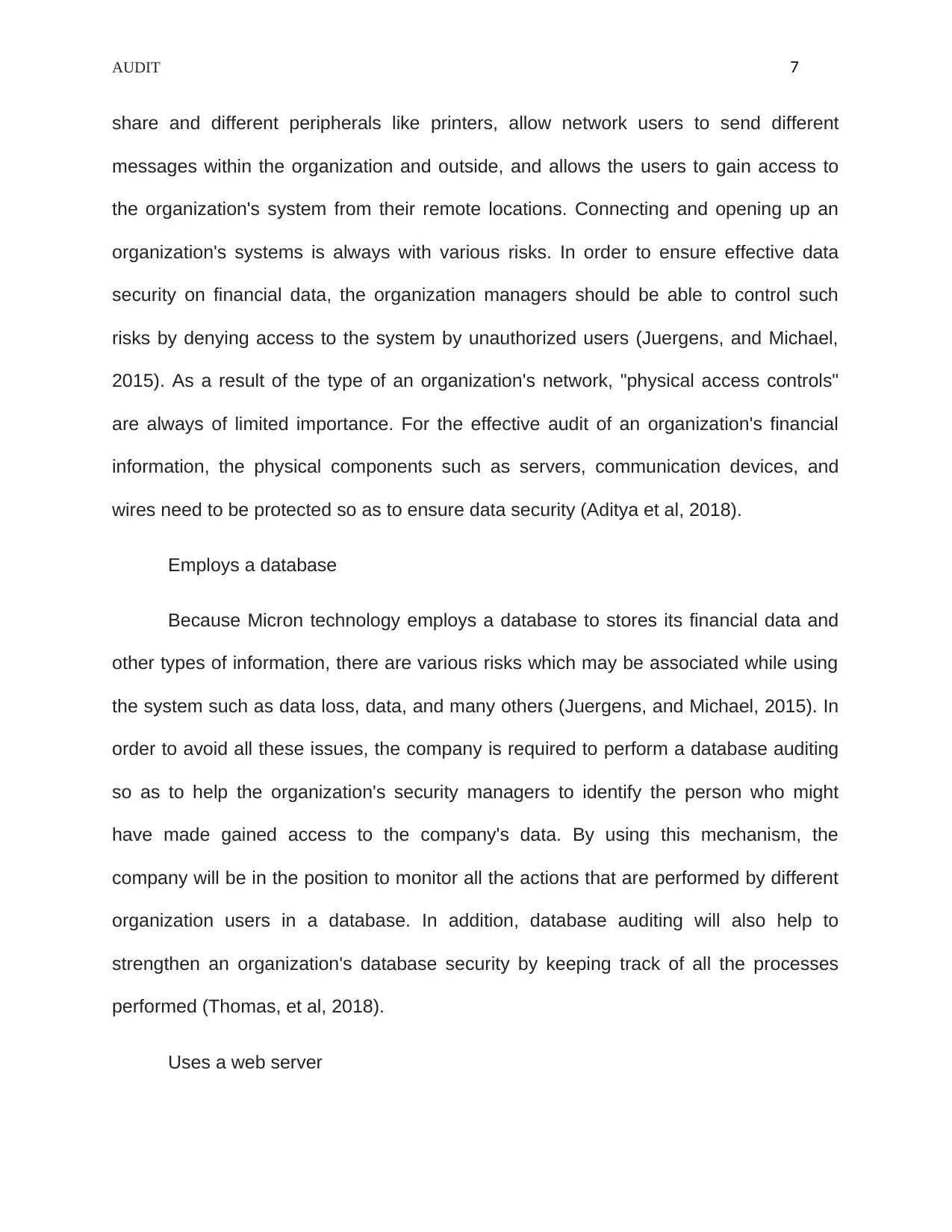
AUDIT 7
share and different peripherals like printers, allow network users to send different
messages within the organization and outside, and allows the users to gain access to
the organization's system from their remote locations. Connecting and opening up an
organization's systems is always with various risks. In order to ensure effective data
security on financial data, the organization managers should be able to control such
risks by denying access to the system by unauthorized users (Juergens, and Michael,
2015). As a result of the type of an organization's network, "physical access controls"
are always of limited importance. For the effective audit of an organization's financial
information, the physical components such as servers, communication devices, and
wires need to be protected so as to ensure data security (Aditya et al, 2018).
Employs a database
Because Micron technology employs a database to stores its financial data and
other types of information, there are various risks which may be associated while using
the system such as data loss, data, and many others (Juergens, and Michael, 2015). In
order to avoid all these issues, the company is required to perform a database auditing
so as to help the organization's security managers to identify the person who might
have made gained access to the company's data. By using this mechanism, the
company will be in the position to monitor all the actions that are performed by different
organization users in a database. In addition, database auditing will also help to
strengthen an organization's database security by keeping track of all the processes
performed (Thomas, et al, 2018).
Uses a web server
share and different peripherals like printers, allow network users to send different
messages within the organization and outside, and allows the users to gain access to
the organization's system from their remote locations. Connecting and opening up an
organization's systems is always with various risks. In order to ensure effective data
security on financial data, the organization managers should be able to control such
risks by denying access to the system by unauthorized users (Juergens, and Michael,
2015). As a result of the type of an organization's network, "physical access controls"
are always of limited importance. For the effective audit of an organization's financial
information, the physical components such as servers, communication devices, and
wires need to be protected so as to ensure data security (Aditya et al, 2018).
Employs a database
Because Micron technology employs a database to stores its financial data and
other types of information, there are various risks which may be associated while using
the system such as data loss, data, and many others (Juergens, and Michael, 2015). In
order to avoid all these issues, the company is required to perform a database auditing
so as to help the organization's security managers to identify the person who might
have made gained access to the company's data. By using this mechanism, the
company will be in the position to monitor all the actions that are performed by different
organization users in a database. In addition, database auditing will also help to
strengthen an organization's database security by keeping track of all the processes
performed (Thomas, et al, 2018).
Uses a web server
Paraphrase This Document
Need a fresh take? Get an instant paraphrase of this document with our AI Paraphraser
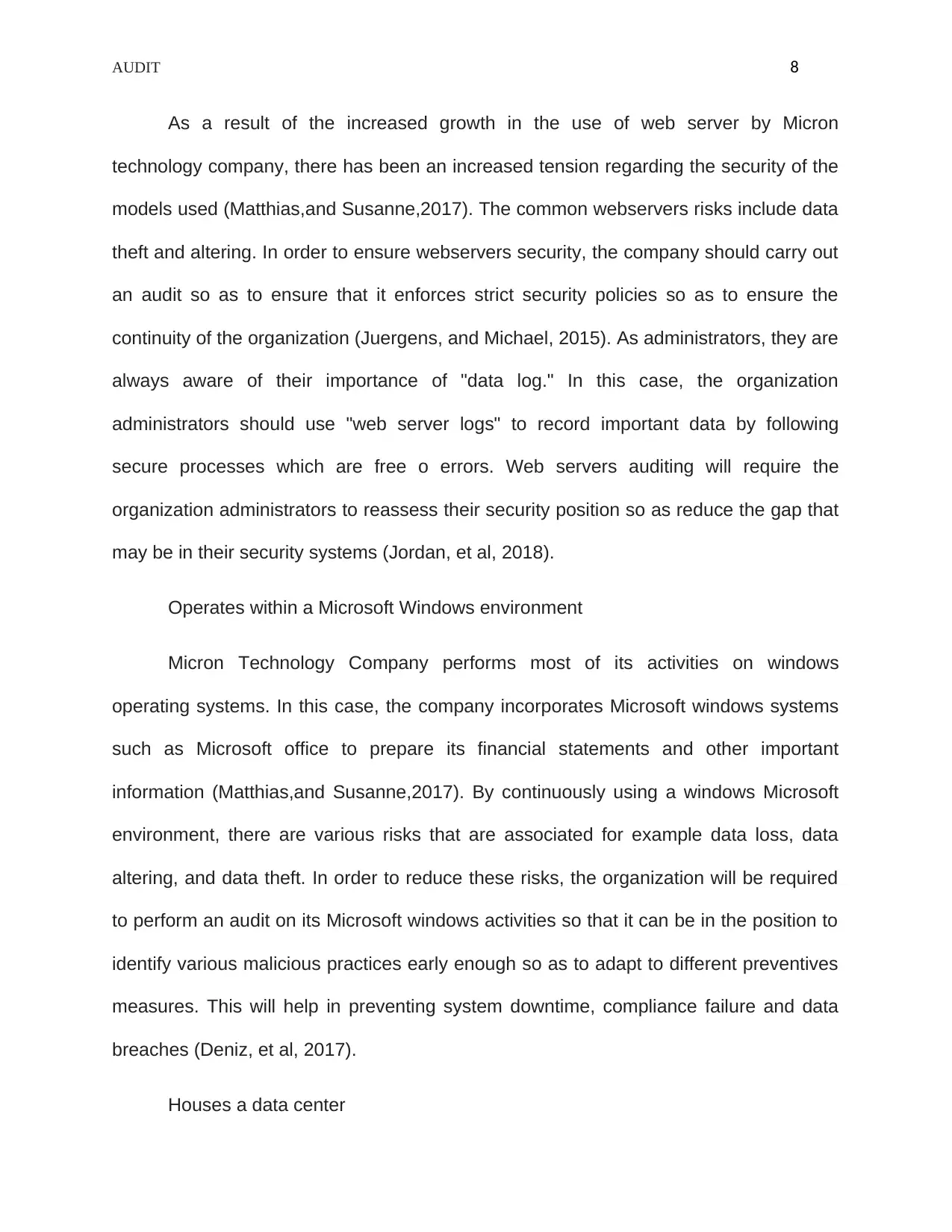
AUDIT 8
As a result of the increased growth in the use of web server by Micron
technology company, there has been an increased tension regarding the security of the
models used (Matthias,and Susanne,2017). The common webservers risks include data
theft and altering. In order to ensure webservers security, the company should carry out
an audit so as to ensure that it enforces strict security policies so as to ensure the
continuity of the organization (Juergens, and Michael, 2015). As administrators, they are
always aware of their importance of "data log." In this case, the organization
administrators should use "web server logs" to record important data by following
secure processes which are free o errors. Web servers auditing will require the
organization administrators to reassess their security position so as reduce the gap that
may be in their security systems (Jordan, et al, 2018).
Operates within a Microsoft Windows environment
Micron Technology Company performs most of its activities on windows
operating systems. In this case, the company incorporates Microsoft windows systems
such as Microsoft office to prepare its financial statements and other important
information (Matthias,and Susanne,2017). By continuously using a windows Microsoft
environment, there are various risks that are associated for example data loss, data
altering, and data theft. In order to reduce these risks, the organization will be required
to perform an audit on its Microsoft windows activities so that it can be in the position to
identify various malicious practices early enough so as to adapt to different preventives
measures. This will help in preventing system downtime, compliance failure and data
breaches (Deniz, et al, 2017).
Houses a data center
As a result of the increased growth in the use of web server by Micron
technology company, there has been an increased tension regarding the security of the
models used (Matthias,and Susanne,2017). The common webservers risks include data
theft and altering. In order to ensure webservers security, the company should carry out
an audit so as to ensure that it enforces strict security policies so as to ensure the
continuity of the organization (Juergens, and Michael, 2015). As administrators, they are
always aware of their importance of "data log." In this case, the organization
administrators should use "web server logs" to record important data by following
secure processes which are free o errors. Web servers auditing will require the
organization administrators to reassess their security position so as reduce the gap that
may be in their security systems (Jordan, et al, 2018).
Operates within a Microsoft Windows environment
Micron Technology Company performs most of its activities on windows
operating systems. In this case, the company incorporates Microsoft windows systems
such as Microsoft office to prepare its financial statements and other important
information (Matthias,and Susanne,2017). By continuously using a windows Microsoft
environment, there are various risks that are associated for example data loss, data
altering, and data theft. In order to reduce these risks, the organization will be required
to perform an audit on its Microsoft windows activities so that it can be in the position to
identify various malicious practices early enough so as to adapt to different preventives
measures. This will help in preventing system downtime, compliance failure and data
breaches (Deniz, et al, 2017).
Houses a data center
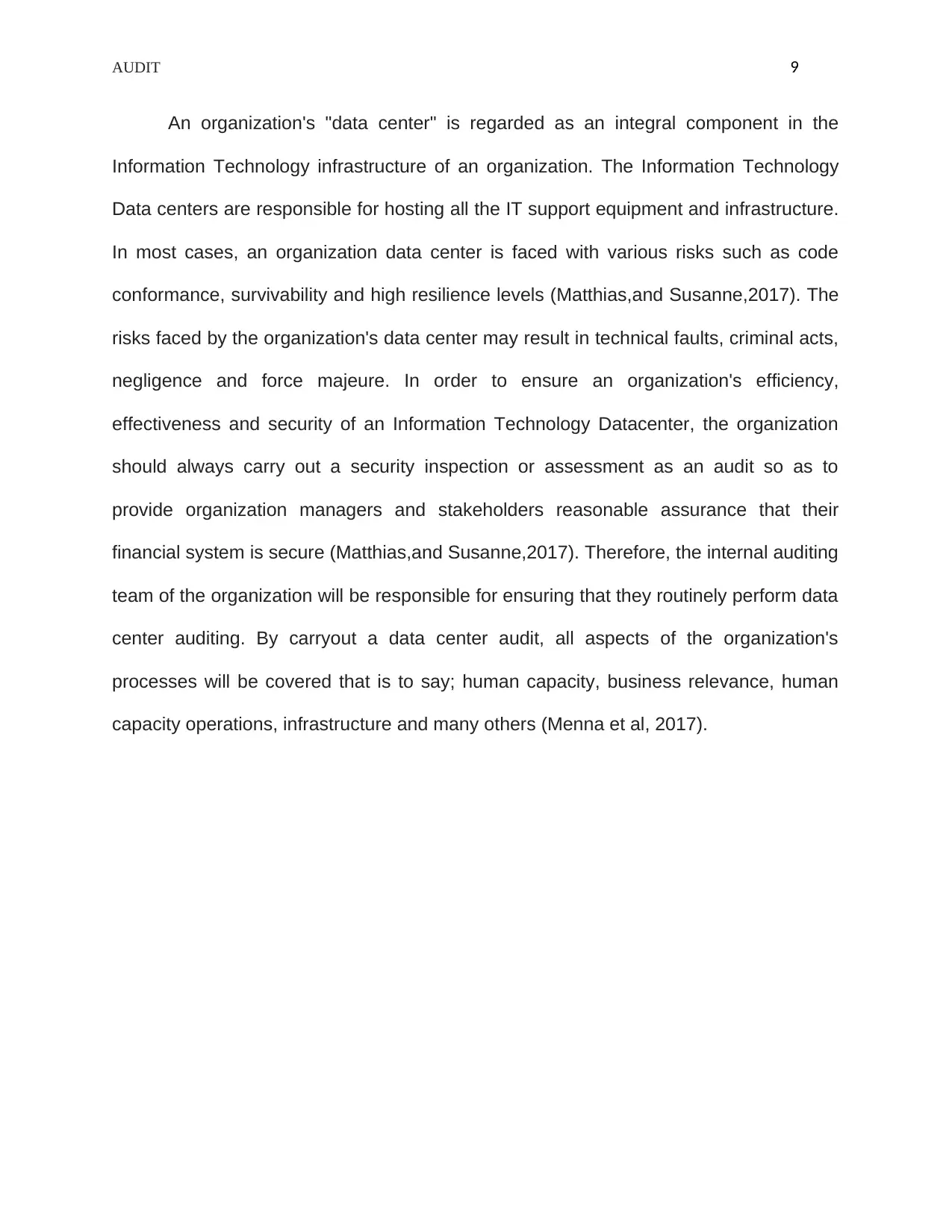
AUDIT 9
An organization's "data center" is regarded as an integral component in the
Information Technology infrastructure of an organization. The Information Technology
Data centers are responsible for hosting all the IT support equipment and infrastructure.
In most cases, an organization data center is faced with various risks such as code
conformance, survivability and high resilience levels (Matthias,and Susanne,2017). The
risks faced by the organization's data center may result in technical faults, criminal acts,
negligence and force majeure. In order to ensure an organization's efficiency,
effectiveness and security of an Information Technology Datacenter, the organization
should always carry out a security inspection or assessment as an audit so as to
provide organization managers and stakeholders reasonable assurance that their
financial system is secure (Matthias,and Susanne,2017). Therefore, the internal auditing
team of the organization will be responsible for ensuring that they routinely perform data
center auditing. By carryout a data center audit, all aspects of the organization's
processes will be covered that is to say; human capacity, business relevance, human
capacity operations, infrastructure and many others (Menna et al, 2017).
An organization's "data center" is regarded as an integral component in the
Information Technology infrastructure of an organization. The Information Technology
Data centers are responsible for hosting all the IT support equipment and infrastructure.
In most cases, an organization data center is faced with various risks such as code
conformance, survivability and high resilience levels (Matthias,and Susanne,2017). The
risks faced by the organization's data center may result in technical faults, criminal acts,
negligence and force majeure. In order to ensure an organization's efficiency,
effectiveness and security of an Information Technology Datacenter, the organization
should always carry out a security inspection or assessment as an audit so as to
provide organization managers and stakeholders reasonable assurance that their
financial system is secure (Matthias,and Susanne,2017). Therefore, the internal auditing
team of the organization will be responsible for ensuring that they routinely perform data
center auditing. By carryout a data center audit, all aspects of the organization's
processes will be covered that is to say; human capacity, business relevance, human
capacity operations, infrastructure and many others (Menna et al, 2017).
⊘ This is a preview!⊘
Do you want full access?
Subscribe today to unlock all pages.

Trusted by 1+ million students worldwide
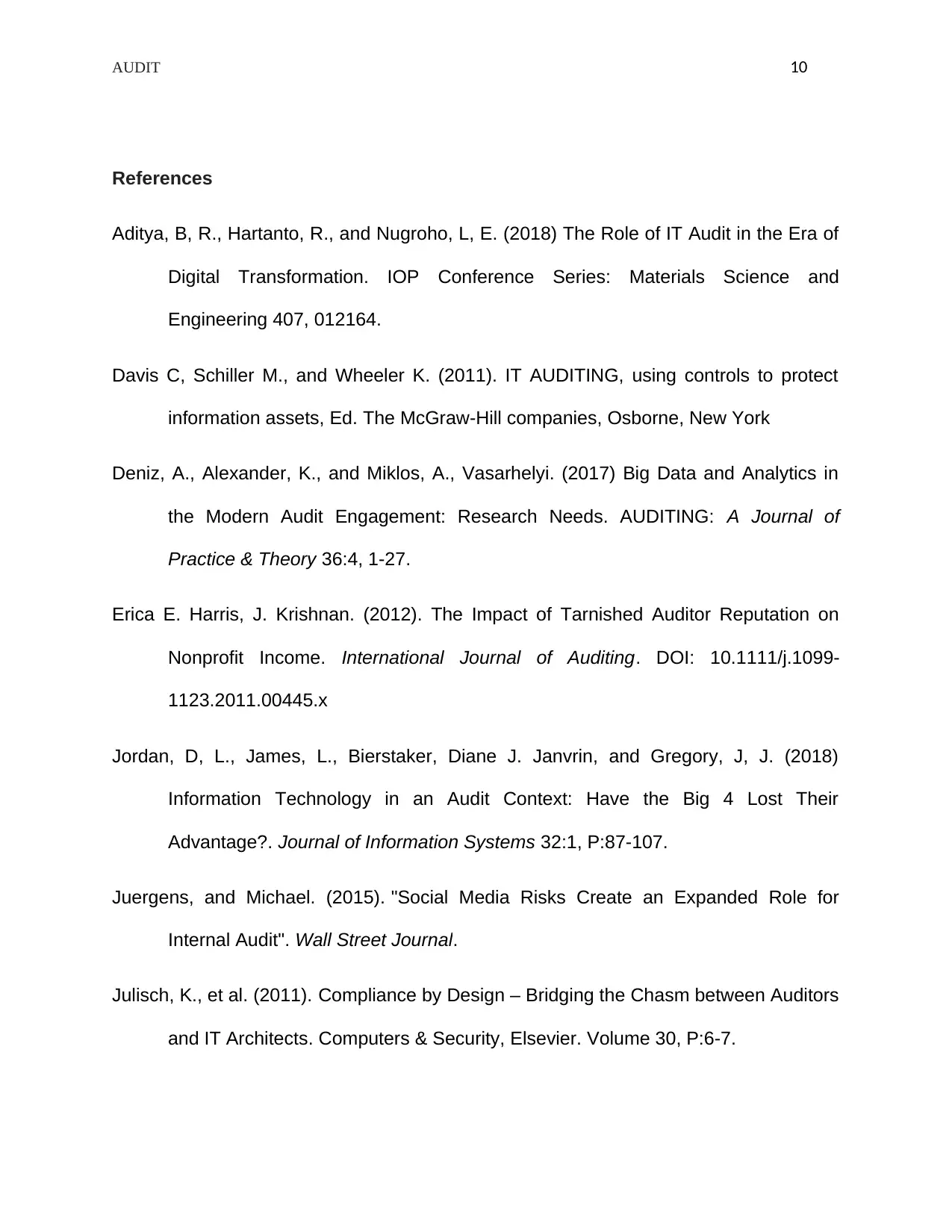
AUDIT 10
References
Aditya, B, R., Hartanto, R., and Nugroho, L, E. (2018) The Role of IT Audit in the Era of
Digital Transformation. IOP Conference Series: Materials Science and
Engineering 407, 012164.
Davis C, Schiller M., and Wheeler K. (2011). IT AUDITING, using controls to protect
information assets, Ed. The McGraw-Hill companies, Osborne, New York
Deniz, A., Alexander, K., and Miklos, A., Vasarhelyi. (2017) Big Data and Analytics in
the Modern Audit Engagement: Research Needs. AUDITING: A Journal of
Practice & Theory 36:4, 1-27.
Erica E. Harris, J. Krishnan. (2012). The Impact of Tarnished Auditor Reputation on
Nonprofit Income. International Journal of Auditing. DOI: 10.1111/j.1099-
1123.2011.00445.x
Jordan, D, L., James, L., Bierstaker, Diane J. Janvrin, and Gregory, J, J. (2018)
Information Technology in an Audit Context: Have the Big 4 Lost Their
Advantage?. Journal of Information Systems 32:1, P:87-107.
Juergens, and Michael. (2015). "Social Media Risks Create an Expanded Role for
Internal Audit". Wall Street Journal.
Julisch, K., et al. (2011). Compliance by Design – Bridging the Chasm between Auditors
and IT Architects. Computers & Security, Elsevier. Volume 30, P:6-7.
References
Aditya, B, R., Hartanto, R., and Nugroho, L, E. (2018) The Role of IT Audit in the Era of
Digital Transformation. IOP Conference Series: Materials Science and
Engineering 407, 012164.
Davis C, Schiller M., and Wheeler K. (2011). IT AUDITING, using controls to protect
information assets, Ed. The McGraw-Hill companies, Osborne, New York
Deniz, A., Alexander, K., and Miklos, A., Vasarhelyi. (2017) Big Data and Analytics in
the Modern Audit Engagement: Research Needs. AUDITING: A Journal of
Practice & Theory 36:4, 1-27.
Erica E. Harris, J. Krishnan. (2012). The Impact of Tarnished Auditor Reputation on
Nonprofit Income. International Journal of Auditing. DOI: 10.1111/j.1099-
1123.2011.00445.x
Jordan, D, L., James, L., Bierstaker, Diane J. Janvrin, and Gregory, J, J. (2018)
Information Technology in an Audit Context: Have the Big 4 Lost Their
Advantage?. Journal of Information Systems 32:1, P:87-107.
Juergens, and Michael. (2015). "Social Media Risks Create an Expanded Role for
Internal Audit". Wall Street Journal.
Julisch, K., et al. (2011). Compliance by Design – Bridging the Chasm between Auditors
and IT Architects. Computers & Security, Elsevier. Volume 30, P:6-7.
Paraphrase This Document
Need a fresh take? Get an instant paraphrase of this document with our AI Paraphraser
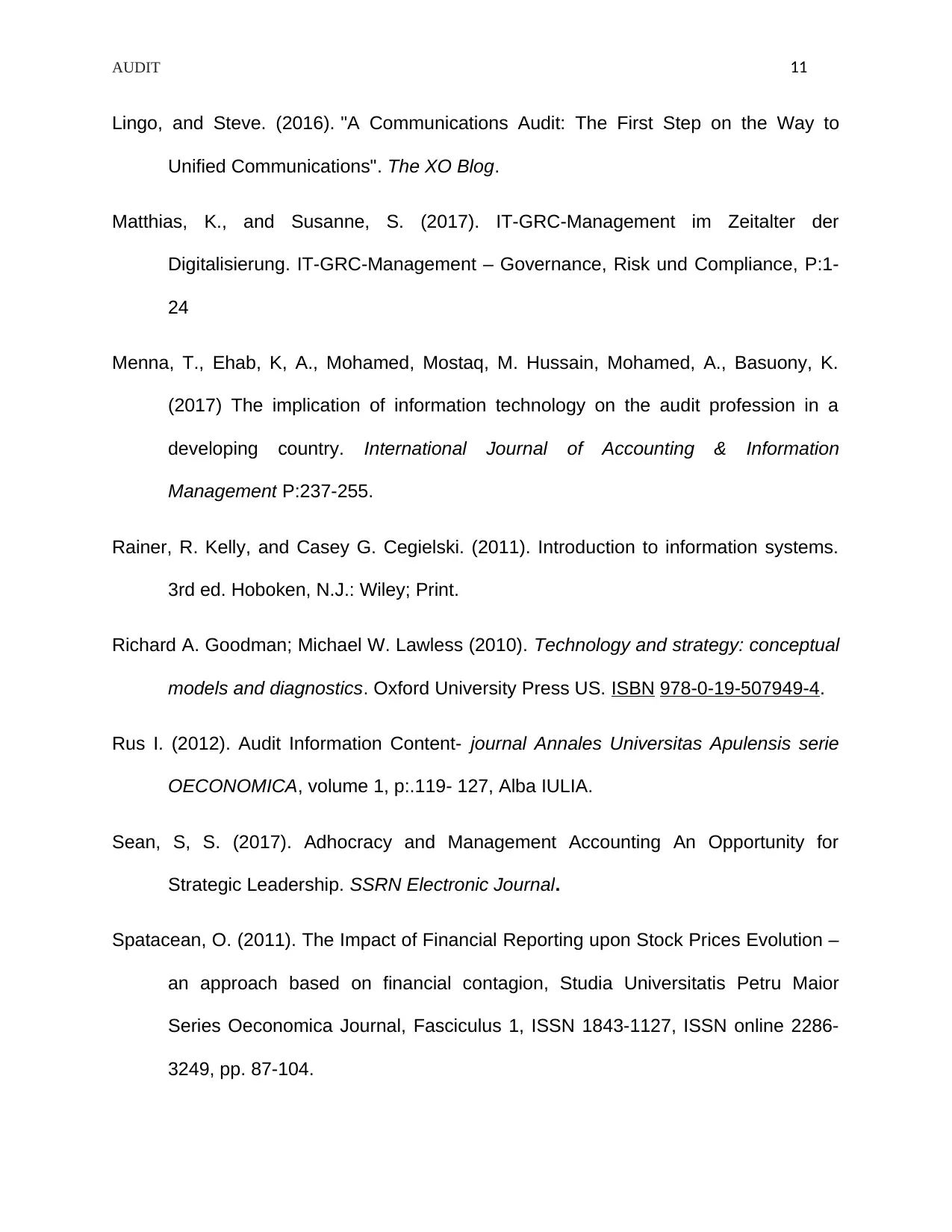
AUDIT 11
Lingo, and Steve. (2016). "A Communications Audit: The First Step on the Way to
Unified Communications". The XO Blog.
Matthias, K., and Susanne, S. (2017). IT-GRC-Management im Zeitalter der
Digitalisierung. IT-GRC-Management – Governance, Risk und Compliance, P:1-
24
Menna, T., Ehab, K, A., Mohamed, Mostaq, M. Hussain, Mohamed, A., Basuony, K.
(2017) The implication of information technology on the audit profession in a
developing country. International Journal of Accounting & Information
Management P:237-255.
Rainer, R. Kelly, and Casey G. Cegielski. (2011). Introduction to information systems.
3rd ed. Hoboken, N.J.: Wiley; Print.
Richard A. Goodman; Michael W. Lawless (2010). Technology and strategy: conceptual
models and diagnostics. Oxford University Press US. ISBN 978-0-19-507949-4.
Rus I. (2012). Audit Information Content- journal Annales Universitas Apulensis serie
OECONOMICA, volume 1, p:.119- 127, Alba IULIA.
Sean, S, S. (2017). Adhocracy and Management Accounting An Opportunity for
Strategic Leadership. SSRN Electronic Journal.
Spatacean, O. (2011). The Impact of Financial Reporting upon Stock Prices Evolution –
an approach based on financial contagion, Studia Universitatis Petru Maior
Series Oeconomica Journal, Fasciculus 1, ISSN 1843-1127, ISSN online 2286-
3249, pp. 87-104.
Lingo, and Steve. (2016). "A Communications Audit: The First Step on the Way to
Unified Communications". The XO Blog.
Matthias, K., and Susanne, S. (2017). IT-GRC-Management im Zeitalter der
Digitalisierung. IT-GRC-Management – Governance, Risk und Compliance, P:1-
24
Menna, T., Ehab, K, A., Mohamed, Mostaq, M. Hussain, Mohamed, A., Basuony, K.
(2017) The implication of information technology on the audit profession in a
developing country. International Journal of Accounting & Information
Management P:237-255.
Rainer, R. Kelly, and Casey G. Cegielski. (2011). Introduction to information systems.
3rd ed. Hoboken, N.J.: Wiley; Print.
Richard A. Goodman; Michael W. Lawless (2010). Technology and strategy: conceptual
models and diagnostics. Oxford University Press US. ISBN 978-0-19-507949-4.
Rus I. (2012). Audit Information Content- journal Annales Universitas Apulensis serie
OECONOMICA, volume 1, p:.119- 127, Alba IULIA.
Sean, S, S. (2017). Adhocracy and Management Accounting An Opportunity for
Strategic Leadership. SSRN Electronic Journal.
Spatacean, O. (2011). The Impact of Financial Reporting upon Stock Prices Evolution –
an approach based on financial contagion, Studia Universitatis Petru Maior
Series Oeconomica Journal, Fasciculus 1, ISSN 1843-1127, ISSN online 2286-
3249, pp. 87-104.
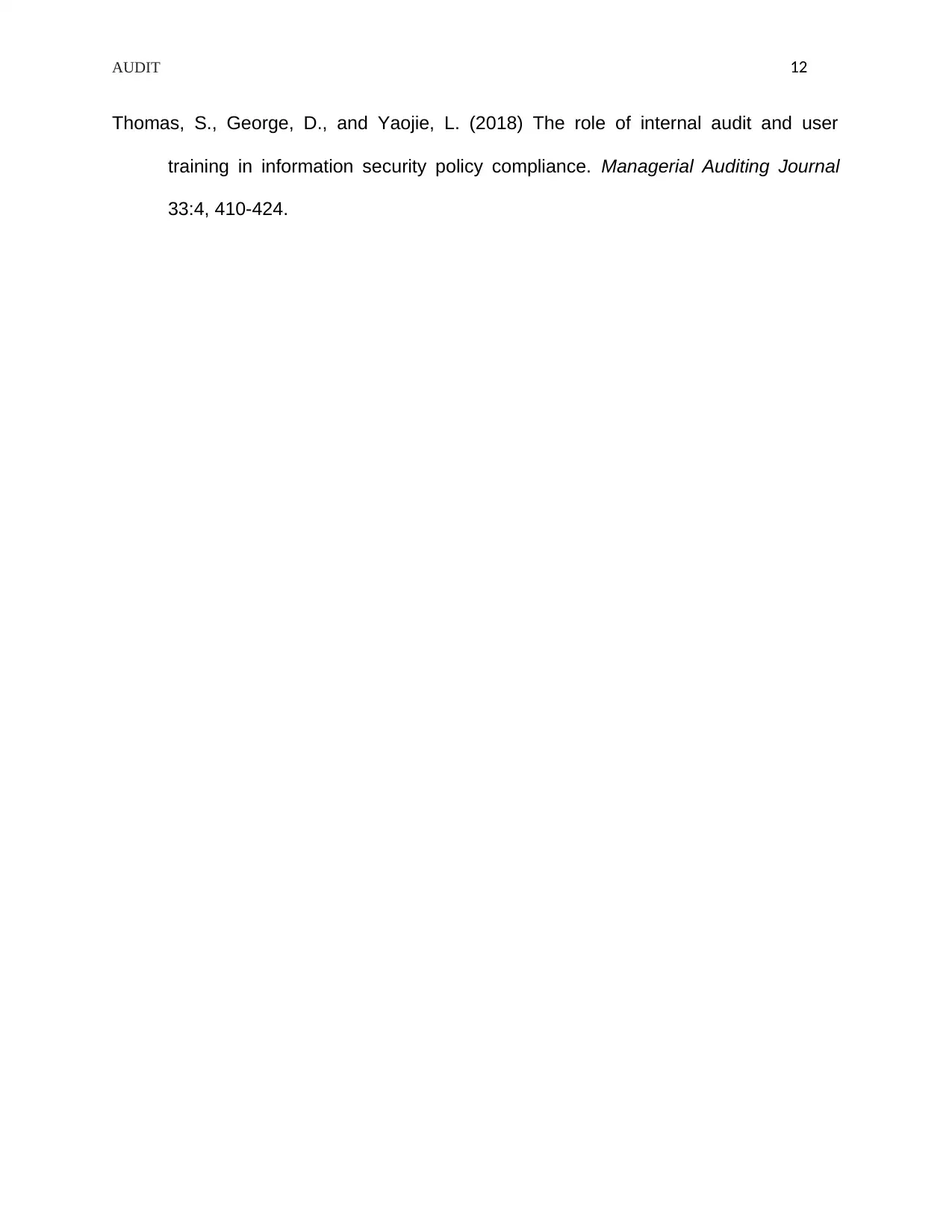
AUDIT 12
Thomas, S., George, D., and Yaojie, L. (2018) The role of internal audit and user
training in information security policy compliance. Managerial Auditing Journal
33:4, 410-424.
Thomas, S., George, D., and Yaojie, L. (2018) The role of internal audit and user
training in information security policy compliance. Managerial Auditing Journal
33:4, 410-424.
⊘ This is a preview!⊘
Do you want full access?
Subscribe today to unlock all pages.

Trusted by 1+ million students worldwide
1 out of 12
Related Documents
Your All-in-One AI-Powered Toolkit for Academic Success.
+13062052269
info@desklib.com
Available 24*7 on WhatsApp / Email
![[object Object]](/_next/static/media/star-bottom.7253800d.svg)
Unlock your academic potential
Copyright © 2020–2025 A2Z Services. All Rights Reserved. Developed and managed by ZUCOL.





